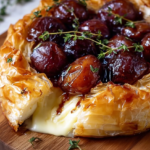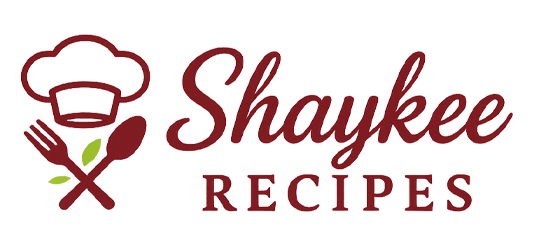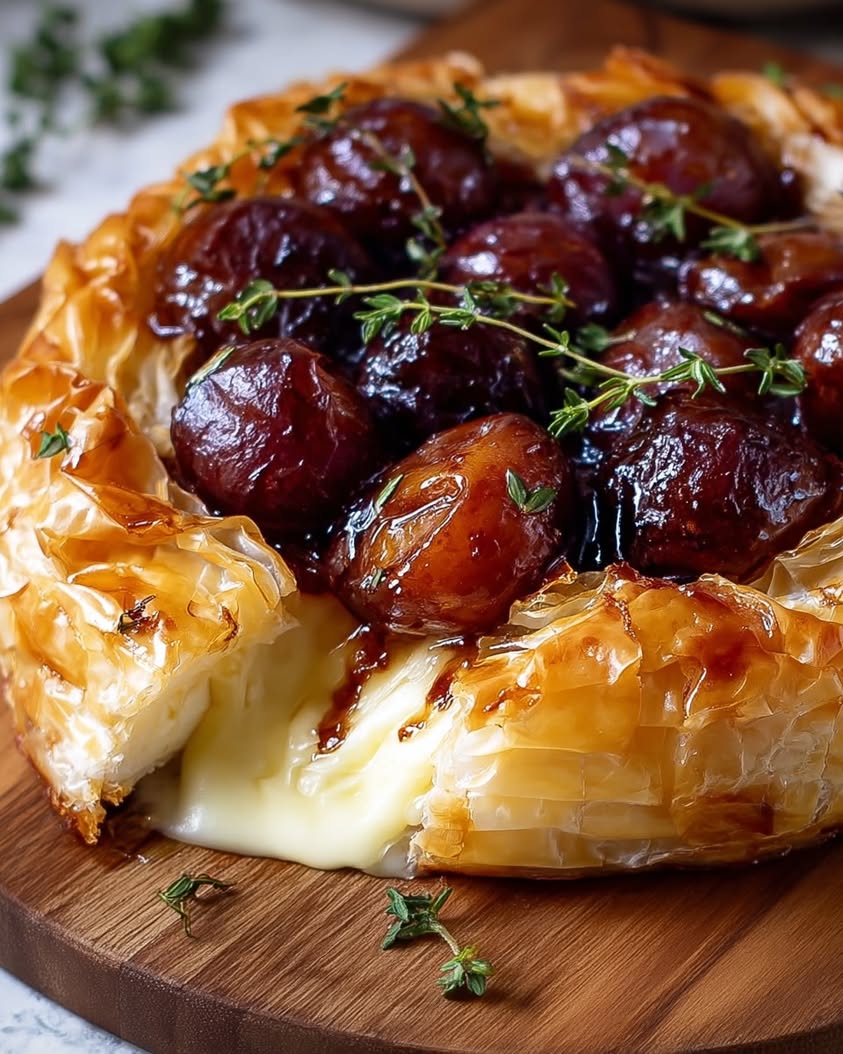Baked Brie with Roasted Plums & Thyme in Phyllo Crust: An Elegant Appetizer for Any Occasion
This baked brie with roasted plums and thyme wrapped in a golden phyllo crust is the perfect blend of sweet and savory. The creamy brie melts into a luscious pool, while the roasted plums add a caramelized depth of flavor. Fresh thyme ties everything together with its earthy aroma. Whether you serve it as an appetizer or a dessert, this dish will impress your guests with minimal effort.
Imagine cutting into the crisp phyllo crust to reveal the gooey brie inside. The plums on top glisten with a sticky glaze, and the scent of thyme fills the air. This recipe works beautifully for holiday gatherings, dinner parties, or even a cozy night in. Best of all, it requires just a handful of ingredients and simple techniques. Even beginner cooks can master this elegant dish.
Quick Recipe Highlights
- Flavor Profile: The rich creaminess of brie balances perfectly with the sweet-tart plums and herbal thyme.
- Texture: Crisp phyllo contrasts with the molten cheese and tender roasted fruit for a satisfying bite.
- Aroma: Warm brie and caramelized plums create an inviting fragrance enhanced by fresh thyme.
- Visual Appeal: The golden-brown crust and vibrant plum topping make this dish Instagram-worthy.
- Skill Level Needed: Basic kitchen skills are sufficient for this straightforward recipe.
- Special Equipment: A baking sheet and pastry brush are the only tools required.
Recipe Overview
- Difficulty Level: This recipe falls into the easy category because it involves simple assembly and baking.
- Category: Perfect as an appetizer or dessert for any gathering.
- Cuisine: Inspired by French flavors with a modern twist.
- Cost: Affordable ingredients make this dish budget-friendly for entertaining.
- Season: Ideal for fall and winter when plums are in season.
- Occasion: Works for holidays, dinner parties, or casual get-togethers.
Why You’ll Love This Recipe
The combination of flavors in this baked brie recipe creates an unforgettable taste experience. Creamy brie provides a rich base, while roasted plums contribute natural sweetness. Thyme adds an herbal note that elevates the entire dish. Every component works in harmony to deliver a balanced bite that keeps you coming back for more.
Convenience is another major advantage of this recipe. With minimal prep time and easy assembly, you can have an impressive dish ready in under an hour. The ingredients are readily available at most grocery stores, making last-minute entertaining stress-free. Even better, the recipe scales easily for larger crowds.
Nutritionally, this dish offers some surprising benefits. Brie contains protein and calcium, while plums provide fiber and antioxidants. Thyme contributes beneficial plant compounds. When enjoyed in moderation, this appetizer can be part of a balanced diet. The portion-controlled servings help prevent overindulgence.
Socially, this baked brie makes a fantastic centerpiece for any gathering. The interactive nature of dipping and sharing creates a convivial atmosphere. Guests will appreciate the thoughtful presentation and restaurant-quality flavors. It’s a guaranteed conversation starter that sets the tone for memorable meals.
Cost-effectiveness makes this recipe accessible to all home cooks. Brie and phyllo dough are affordable luxuries, while plums and thyme are inexpensive additions. The impressive results far outweigh the modest investment. You’ll achieve gourmet quality without the gourmet price tag.
Historical Background and Cultural Significance
Baked brie has its roots in French culinary tradition, where cheese plays a central role in meals. The practice of baking cheese dates back centuries as a way to enhance its texture and flavor. French cooks traditionally served baked brie with simple accompaniments like bread or fruit.
The addition of phyllo crust represents a modern interpretation of this classic dish. Phyllo dough originates from Middle Eastern and Mediterranean cuisines, where layered pastries are common. Combining these culinary traditions creates a fusion dish that honors both cultures while offering something new.
Roasted fruit toppings have become increasingly popular in contemporary cuisine. The technique of caramelizing fruit brings out its natural sugars while adding complexity. Plums work particularly well because they hold their shape during baking while becoming jammy in texture.
Regional variations of baked brie exist throughout Europe and North America. Some versions use puff pastry instead of phyllo, while others incorporate different fruits or nuts. The thyme in this recipe adds a Provençal touch that complements the French cheese beautifully.
Ingredient Deep Dive
Brie cheese forms the heart of this recipe. This soft cow’s milk cheese originated in the Île-de-France region and has been enjoyed since the 8th century. Its edible rind and creamy interior make it ideal for baking. When heated, brie becomes luxuriously molten while maintaining its rich flavor profile.
Plums bring natural sweetness and acidity to balance the rich cheese. These stone fruits have been cultivated for thousands of years and come in many varieties. For this recipe, choose ripe but firm plums that will hold their shape during roasting. Their deep purple skin adds visual appeal to the finished dish.
Fresh thyme provides an aromatic counterpoint to the other ingredients. This Mediterranean herb has been used since ancient times for both culinary and medicinal purposes. Its small leaves pack intense flavor that withstands baking. Thyme pairs particularly well with both cheese and stone fruits.
Phyllo dough creates the crisp outer layer that contrasts with the soft fillings. This paper-thin pastry requires careful handling to prevent tearing. When brushed with butter and baked, it becomes golden and flaky. Phyllo adds texture without overwhelming the delicate flavors of the other components.
Common Mistakes to Avoid
- Overbaking the brie can cause it to become greasy instead of creamy. Watch carefully during the final minutes.
- Using unripe plums will result in tart, firm fruit that doesn’t caramelize properly.
- Skipping the butter between phyllo layers leads to a dry, tough crust rather than flaky perfection.
- Cutting the brie too soon after baking causes the cheese to ooze out uncontrollably.
- Overcrowding the baking sheet prevents proper air circulation and even browning.
- Neglecting to score the plums before roasting means they won’t release their juices properly.
- Using dried thyme instead of fresh results in a dusty texture and muted flavor.
- Forgetting to let the brie come to room temperature before baking affects melting consistency.
Essential Techniques
Proper phyllo handling ensures a crisp, flaky crust. Always keep unused sheets covered with a damp towel to prevent drying. Work quickly when brushing with butter to maintain pliability. Layering multiple sheets creates structural integrity while allowing for delicate shattering when cut.
Roasting the plums concentrates their natural sugars. Cutting them into uniform pieces promotes even cooking. A moderate oven temperature allows gradual caramelization without burning. The juices released during roasting create a natural sauce that enhances the brie.
Wrapping the brie requires careful folding to contain the melting cheese. Leaving the top slightly open allows steam to escape while baking. Sealing the edges properly prevents leaks that could make the phyllo soggy. The finished package should be snug but not tight.
Pro Tips for Perfect Baked Brie
- Select a brie wheel with even thickness for consistent melting.
- Brush melted butter all the way to the edges of each phyllo sheet.
- Add a sprinkle of brown sugar to the plums for extra caramelization.
- Let the baked brie rest for 5 minutes before serving for ideal texture.
- Use kitchen shears to trim excess phyllo for a neat presentation.
- Garnish with additional fresh thyme sprigs for visual appeal.
Variations and Adaptations
For a seasonal twist, try substituting peaches or figs for the plums. Apples and pears work beautifully in autumn, while berries shine in summer. The basic technique remains the same regardless of the fruit you choose. Experiment with different combinations to suit your taste.
Dietary modifications are simple with this versatile recipe. Gluten-free phyllo dough is available for those with sensitivities. Vegan brie alternatives can replace traditional cheese. For a lower-carb version, reduce the number of phyllo layers or omit them entirely.
Flavor variations abound with different herb and spice combinations. Rosemary or sage can stand in for thyme. A pinch of cinnamon or nutmeg enhances the fruit’s natural sweetness. For a savory edge, add cracked black pepper or crushed red pepper flakes.
Serving and Presentation Guide
Presentation matters with this showstopping dish. Transfer the baked brie to a wooden board or decorative platter for serving. Arrange the roasted plums artfully on top, letting some cascade down the sides. Provide small knives or spreaders for guests to serve themselves.
Accompaniments should complement without overwhelming. Thinly sliced baguette, crackers, or apple slices make perfect vehicles for the creamy cheese. Include small bowls of honey or jam for those who prefer extra sweetness. A simple green salad balances the richness.
Temperature considerations affect the eating experience. The brie should be served warm enough to maintain its molten texture but not so hot that it burns mouths. The plums taste best at room temperature, allowing their flavors to shine.
Wine and Beverage Pairing
Wine pairings should highlight the dish’s balanced flavors. A crisp white like Sauvignon Blanc cuts through the richness of the cheese. Light-bodied reds such as Pinot Noir complement the fruit without overpowering. Sparkling wines add celebratory flair while cleansing the palate.
Non-alcoholic options work equally well. Iced herbal tea mirrors the thyme notes in the dish. Sparkling water with citrus slices refreshes between bites. For cooler weather, spiced apple cider makes a comforting companion.
Storage and Shelf Life
Leftovers store well for short periods. Refrigerate any uneaten portions in an airtight container for up to two days. Reheat gently in a low oven to restore texture. The phyllo will lose some crispness but remains tasty.
Freezing is not recommended for this dish. The cheese texture changes upon thawing, becoming grainy. Phyllo dough turns soggy when frozen after baking. For best results, enjoy this recipe fresh.
Make Ahead Strategies
Partial preparation saves time when entertaining. Roast the plums up to two days in advance and refrigerate. Bring to room temperature before using. The brie can be wrapped in phyllo several hours ahead and refrigerated until baking time.
For last-minute assembly, have all components prepped and ready. Keep phyllo sheets covered to prevent drying. Melt the butter in advance for quick brushing. Measure out thyme leaves so they’re at hand when needed.
Scaling Instructions
Doubling the recipe works well for larger gatherings. Use two baking sheets to allow proper air circulation. Rotate pans halfway through baking for even results. Increase roasting time slightly if cooking multiple batches of plums.
For smaller servings, cut the brie wheel into wedges before wrapping. Adjust plum quantities proportionally. Reduce baking time by a few minutes when working with smaller portions.
Nutritional Deep Dive
This dish provides a balance of macronutrients. The cheese offers protein and fat, while the fruit contributes carbohydrates. Thyme adds trace minerals like iron and manganese. Together, they create a satisfying bite that satisfies multiple cravings.
Portion control helps manage calorie intake. A single serving provides enough richness to feel indulgent without being excessive. Pairing with fresh vegetables or lean proteins creates a more balanced meal.
Dietary Adaptations
Gluten-free versions simply require substituting gluten-free phyllo dough. Many brands now offer this alternative with similar performance to traditional phyllo. Check labels carefully as formulations vary between manufacturers.
Vegan adaptations use plant-based brie alternatives. Several companies now produce convincing dairy-free versions that melt similarly to real cheese. Coconut oil can replace butter for brushing the phyllo sheets.
Troubleshooting Guide
If the phyllo tears during assembly, simply patch with another buttered sheet. Small imperfections won’t affect the final product. For major tears, start fresh with new layers.
When cheese leaks during baking, don’t panic. The flavor remains intact even if the presentation suffers. Use a spoon to scoop any escaped cheese back onto the serving platter.
Recipe Success Stories
Home cooks consistently report impressive results with this recipe. Many describe it becoming their go-to appetizer for special occasions. Some have adapted it successfully for various dietary needs with excellent feedback from guests.
Photography tips highlight the importance of natural lighting. Shooting the baked brie immediately after removal from the oven captures the steam rising from melted cheese. Close-ups of the plum topping showcase its glossy finish.
Frequently Asked Questions
Can I use puff pastry instead of phyllo? Yes, though the texture will be different. Puff pastry creates a thicker, bread-like crust compared to phyllo’s delicate flakes.
How do I know when the brie is properly melted? The cheese should feel soft when gently pressed with a spoon. It will continue to melt slightly after removal from the oven.
Can I prepare this entirely in advance? For best results, bake just before serving. You can assemble ahead and refrigerate for a few hours before baking.
What if I can’t find fresh plums? Dried plums reconstituted in warm water work in a pinch. Other fruits like apricots or cherries also substitute well.
How do I prevent the bottom from getting soggy? Bake on a wire rack set over a baking sheet to allow air circulation underneath.
Can I make individual portions? Absolutely. Use small brie rounds or cut a large wheel into wedges before wrapping.
What’s the best way to reheat leftovers? A low oven (300°F) for 10-15 minutes restores texture better than microwaving.
Can I freeze the assembled unbaked brie? Freezing isn’t recommended as it affects the phyllo’s texture. Prepare fresh for best results.
How do I prevent the phyllo from burning? Tent with foil if browning too quickly. The crust should be golden, not dark brown.
What other herbs work besides thyme? Rosemary, sage, or oregano all complement the flavors beautifully.
Additional Resources
For those who enjoy this recipe, consider exploring other baked cheese dishes. Camembert and goat cheese adapt well to similar preparations. Fruit and cheese pairings offer endless possibilities for creative entertaining.
Technique guides for working with phyllo dough can help build confidence. Mastering this versatile ingredient opens doors to numerous sweet and savory applications. With practice, handling the delicate sheets becomes second nature.
Seasonal variations keep this recipe fresh year-round. Spring might feature strawberries and rhubarb, while winter could highlight pomegranate and citrus. Let nature’s bounty inspire your culinary creativity.
Print
Baked Brie with Roasted Plums & Thyme in Phyllo Crust
Description
A decadent appetizer featuring creamy brie, sweet roasted plums, and fragrant thyme wrapped in a crispy phyllo crust.
Ingredients
For the Crust:
- 1 wheel of brie (8 oz)
- 4 plums, pitted and sliced
- 1 tbsp fresh thyme leaves
- 2 tbsp honey
- 6 sheets phyllo dough
- 4 tbsp melted butter
- 1/4 tsp salt
- 1/4 tsp black pepper
Instructions
1. Prepare the Crust:
- Preheat oven to 375°F (190°C). Toss plum slices with honey, thyme, salt, and pepper. Roast on a baking sheet for 15 minutes until softened.
- Layer phyllo sheets on a clean surface, brushing each with melted butter. Place brie wheel in the center, top with roasted plums, and fold phyllo over to encase.
- Brush the outside with remaining butter and bake for 20-25 minutes until golden brown. Let cool for 5 minutes before serving.
Notes
You can customize the seasonings to taste.
I’m Shaykee—born in Morocco, seasoned across continents. From airplane galleys to home kitchens, I share the flavors and stories that shaped my journey.

